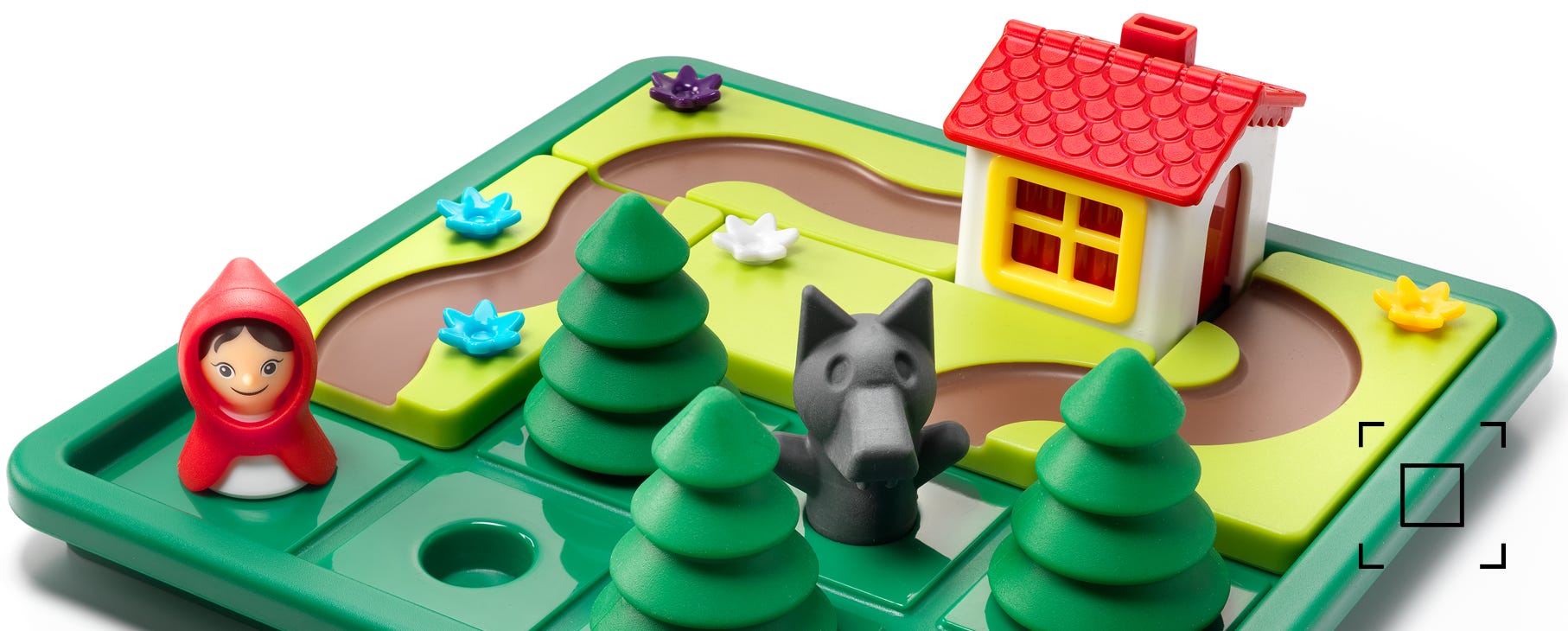
Little Red Riding Hood deluxe
The story behind the creation of Little Red Riding Hood Deluxe
Raf Peeters, January 2016
Three Little Piggies was a commercial success in 2015 and won several international awards. So it was no surprise that they asked me to design another puzzle game with a fairy tale for 2016. For Three Little Piggies I started with a game concept and the theme followed later. For this new game I worked the other way around.
ONCE UPON A TIME ...
The first thing I did was make a list of all possible fairy tales. The most important criterium was to find a story that is well know all around the world. The second criterium is that if you summarize the story, this should also explain the game rules and result in some kind of puzzle. For example in Three Little Piggies this is:
“3 little piggies build 3 different houses so they can hide inside when the wolf comes”. Unfortunately not so many fairy tales can be summarized like that. But in several tales the main character does need to find a path to somewhere. And paths are ideal as a puzzle, either as a connection puzzle or a maze.
I could have used Little Thumb or Hansel & Gretel, but I ended up with the story of Little Red Riding Hood. The idea was simple: you have a start position (the girl), an end position (the house of grandma) and some obstacles (3 pine trees). The object of the game is to connect the starting and end position using tiles with paths. Originally the concept was similar to a simplified version of Anaconda with rectangular tiles. In the first prototype the 5 tiles were double sided, so that you could flip over the tiles that you didn’t need to make the path, just like you do with Anaconda.
But because this game was intended for young children, this felt too complicated. How many young children would fill up the grid with the empty sides of the tiles, once they found the solution? So we decided to further simplify the design and in the final product the tiles only have 1 usable side. Puzzle pieces you don’t need for the solution, can stay outside the grid.
Easy challenges only require 1 puzzle piece to be placed on the grid. For the hardest challenges you need all 5 pieces. For adults challenges with only 1 or 2 puzzle pieces seems very simple, but if you ask the same to a 4 year old, you will see that they often have to try each puzzle piece one by one. They can’t solve the puzzle in their head and have to try it with the real puzzle pieces. When they grow older or become better in this puzzle, you will notice how they start playing differently. They look for specific puzzle pieces and know that some path parts will not work before the place it on the game board.
THE BIG BAD WOLF SHOWS UP ... AGAIN
There are 2 playing modes, just like Three Little Piggies has. On the frontside of the challenge booklet there are 24 challenges with only Red Riding Hood. On the flip side of the same challenge booklet there are 24 challenges with the girl AND the wolf. In these challenges you have to make a separate path to connect them both to the house. Their paths will connect each to a different door of the house, because there are no puzzle pieces with junctions.
Although the concept is simple, we put a lot of time into getting all the details right:
• The house has 3 doors. So it’s not always clear to which side of the house you need to create your path, making the challenges more interesting. When you do the set-up you must make sure that the side with the window is orientated correctly. You can find this orientation by looking at the position of the chimney (the window is on the opposite side).
• For children it would have been easier to have a door on each side of the house. But a house with 4 doors and no window, didn’t really seem attractive. Although I used the same wolf from the other fairy tale game, I decided not to use the houses. Grandma does not live in a pig house! She has a nicer and bigger house, but the curtains behind the windows are closed. After all, she is supposed to be sleeping in bed, being a little ill.
• The trees in the first prototype were broadleaf trees. They looked nice, but in combination with the house and girl, the game looked more like a garden instead of a forest. So we changed them to pine trees. Fortunately, we designed already pine trees for another game (with pine trees and UFO’s) last year. That game was never published, because the game play was considered too complex. But it’s nice that nothing is wasted when you are creating things. Sooner or later you can use it for something else. Now I only have to come up with a second use for UFO’s.
I can’t remember exactly why we originally added the flowers. I think just because I wanted to add some color to a game with a lot of green and brown. It also makes sense in the story. After all, the girl get’s lost in the forest, because she wanted to pick up some flowers for her grandma. In the final game the flowers do have a function. They make it easier for kids to pick up the puzzle pieces and they also provide hints. Some children may notice that the flowers below each challenge indicate which puzzle pieces they need for the solution. They may also discover that the path for the wolf is always shorter than the path for the girl, because in the original story the wolf reaches Grandma’s house first. Don’t reveal these little secrets about the game. Children will feel smart when they can discover those hints themselves.
Similar to Three Little Piggies, this game includes a picture book with the story of Little Red Riding Hood, again illustrated by my colleague Hans Bloemmen. The hardest part was how make illustrations showing how the wolf eats grandma and the girl and how they come out of his belly again at the end of the story. We had to be a little creative here. I checked a lot of existing story books with illustrations of Little Red Riding Hood, but for some reason they always leave this part of the story up to the imagination of the reader. They just say: “The hunter cuts open the wolf and grandma and Red Riding Hood come out alive.” It surprises me that the wolf never wakes up when they open or close him. He wakes up later with only a heavy feeling in his stomach. I guess, this can only happen in fairy tales. I don’t really like it that the wolf is the bad guy again. But that’s how the story goes. In reality most wolfs seldom harm any humans and it’s a good thing that they start populating parts of Europe again, where they used to be extinct. The only thing we could do is to treat the wolf with a little more respect at the end than in the original fairy tale.
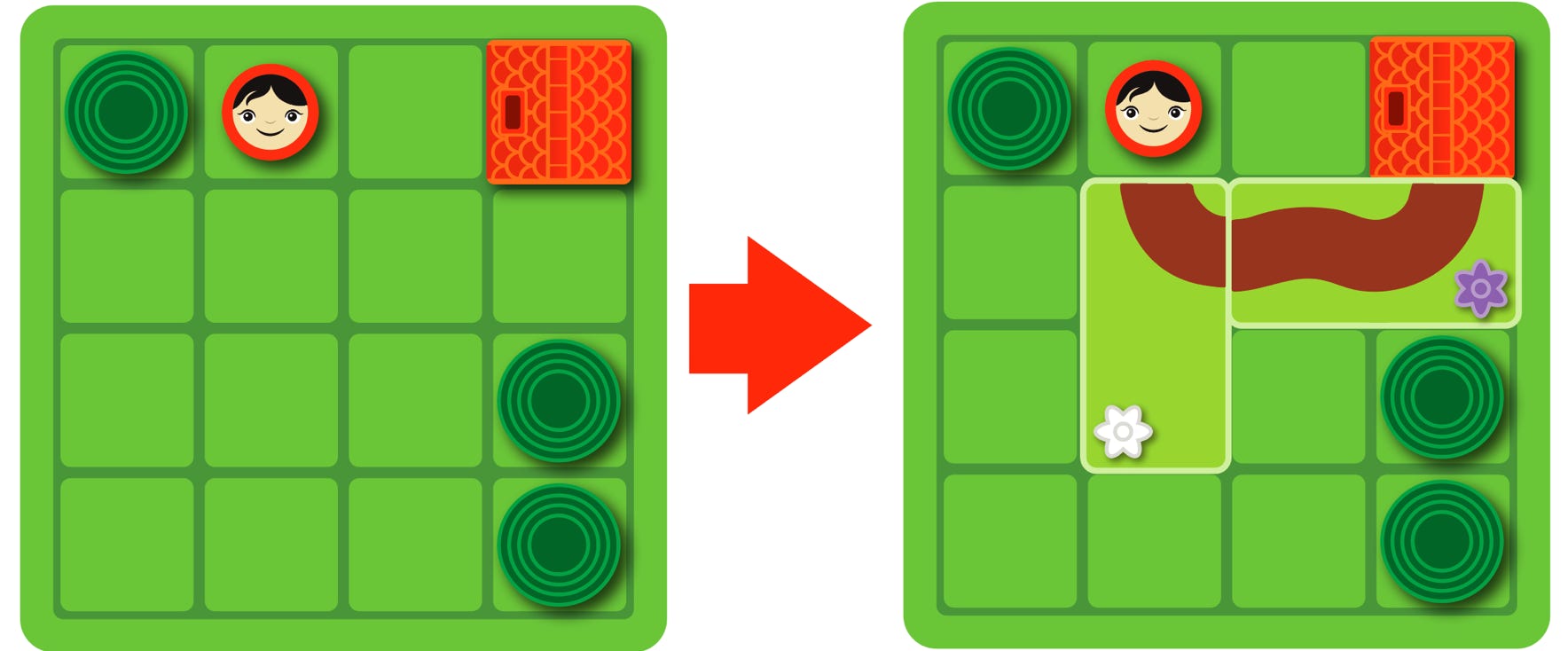
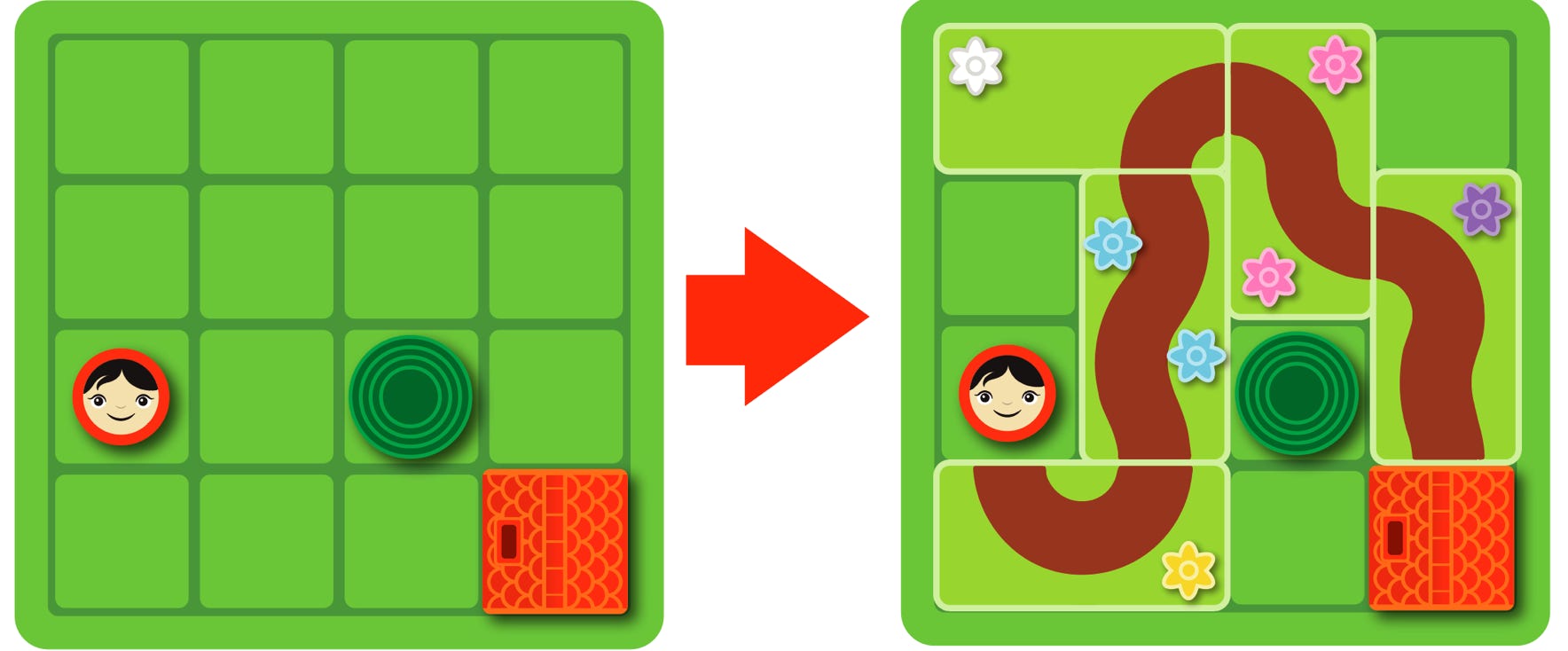

example of a Starter challenge/solution (top) and a Master challenge/ solution (bottom) without the wolf
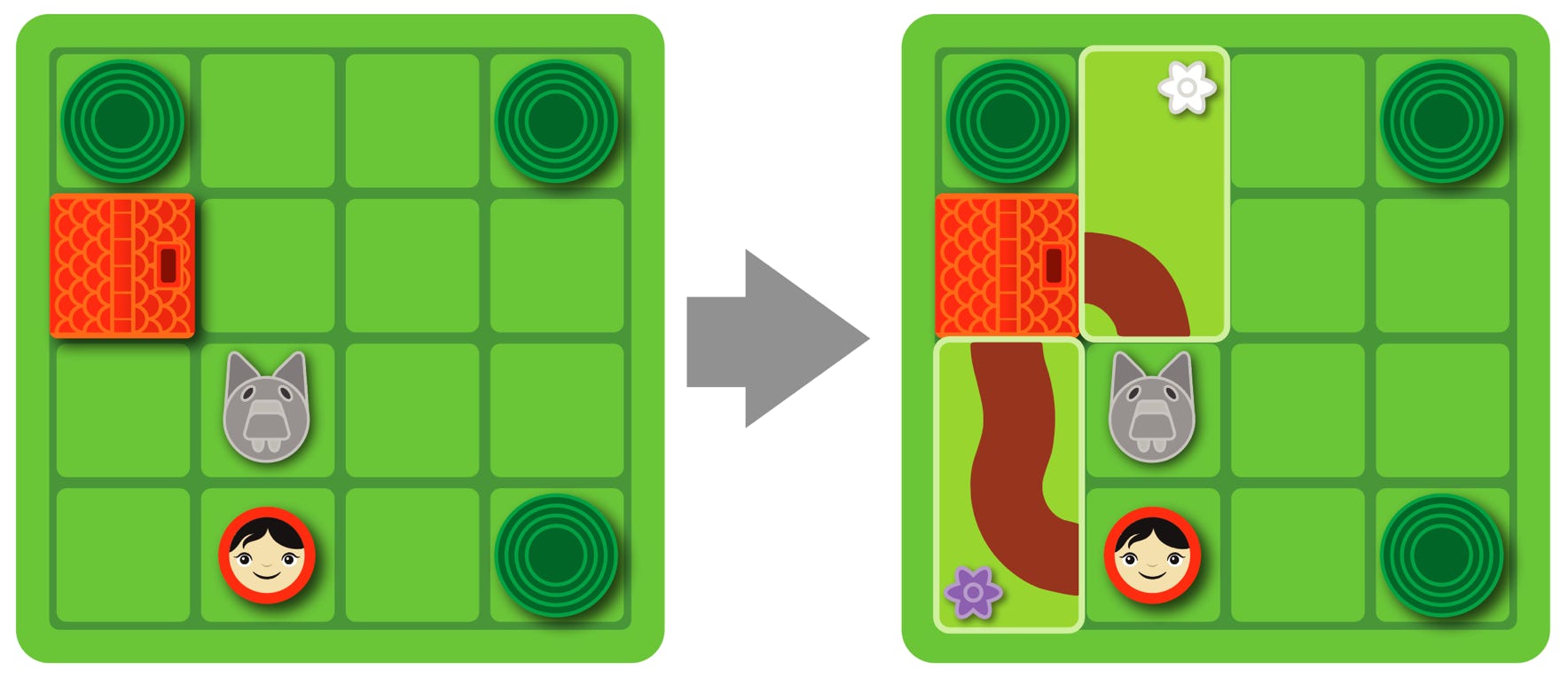
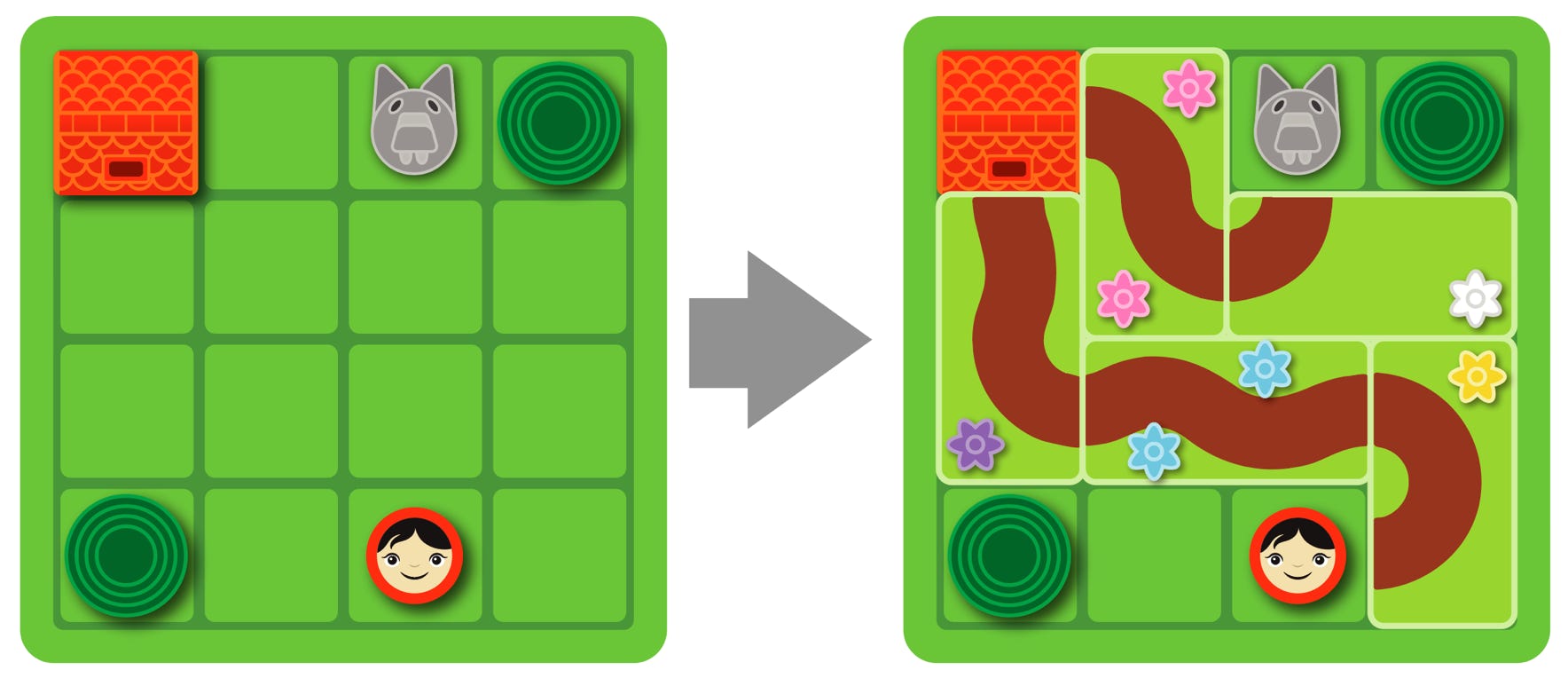
example of a Starter challenge/solution (top) and a Master challenge/ solution (bottom) with the wolf
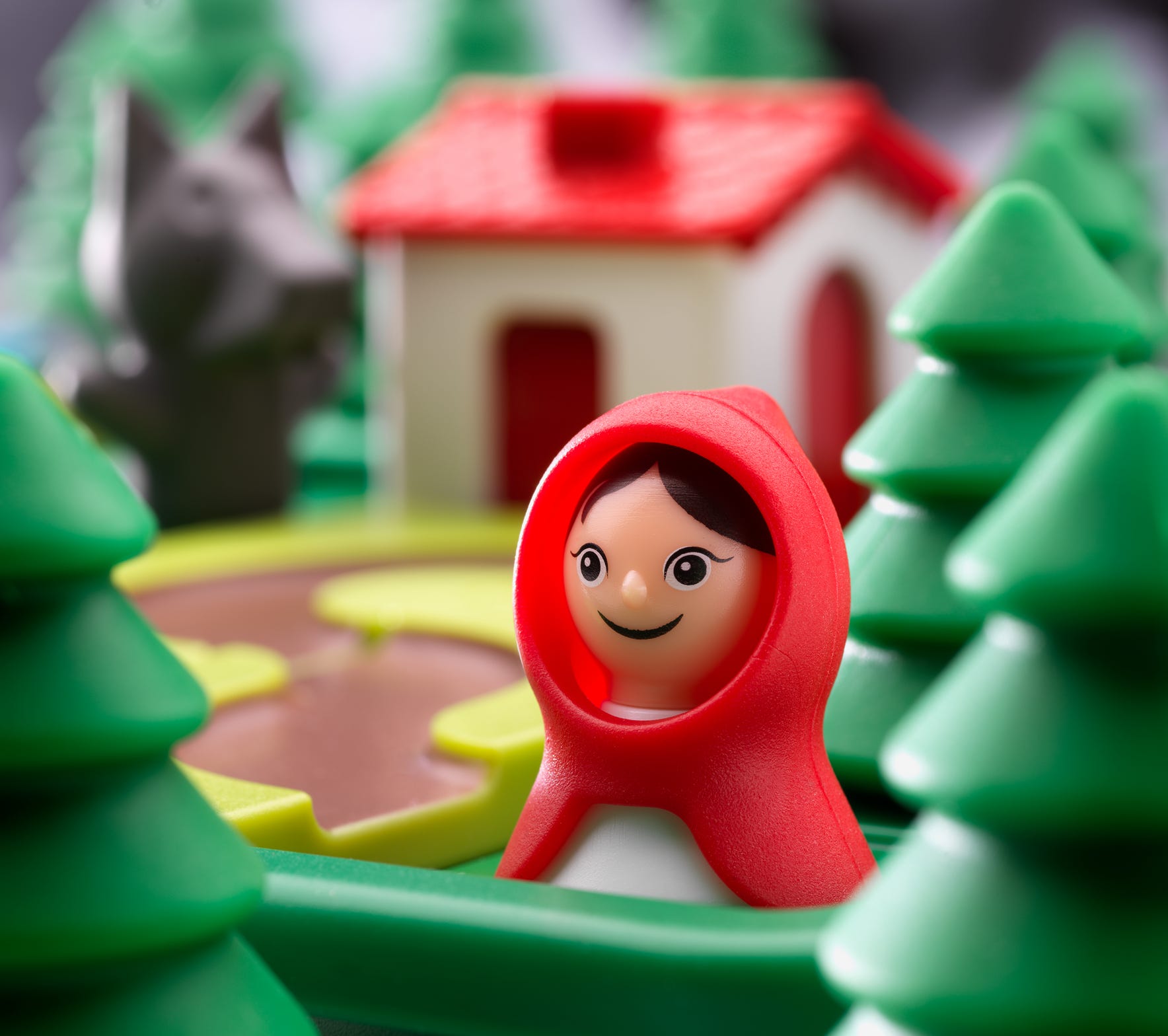
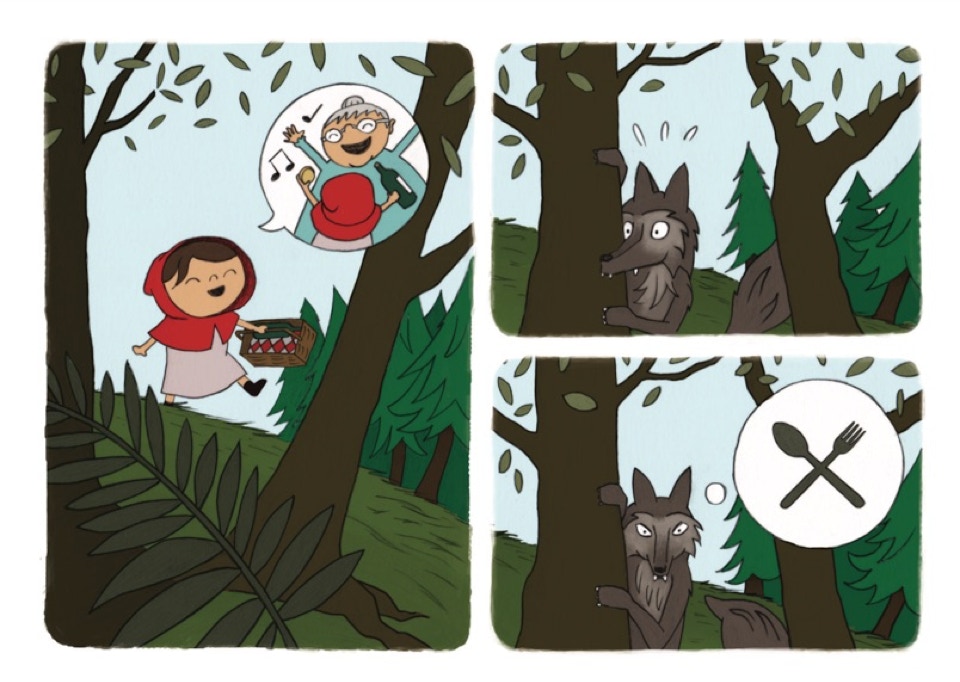
GAME RULES LITTLE RED RIDING HOOD DELUXE
WITHOUT THE WOLF
1. Choose a challenge. Place the house, trees and Red Riding Hood on the game board as indicated. Make sure you pay attention to the position of the chimney on the house, so that the doors are facing the correct direction. You are not allowed to move these pieces as you solve the challenge.
2. Create a path for Red Riding Hood to find Grandma’s house. As the challenges get more difficult, more puzzle pieces (roads) will be needed. Some of the squares on the board may remain empty.
3. There is only 1 solution, which can be found on the backside of each challenge in the booklet.
WITH THE WOLF
1. Choose a challenge. Place the house, trees, Red Riding Hood and the wolf on the game board as indicated. Make sure you pay attention to the position of the chimney on the house, so that the doors are facing the correct direction. You are not allowed to move these pieces as you solve the challenge.
2. Create 2 different paths. One path to connect Red Riding Hood to the house, the other path to connect the wolf to the house. Both paths must connect with a different door at the house! As the challenges get more difficult, more puzzle pieces (roads) will be needed. Some of the squares on the board may remain empty.
3. There is only 1 solution, which can be found on the backside of each challenge in the booklet.
HINTS FOR PARENTS & TEACHERS
Most children will need assistance when they start playing the game. Placing all figures in the right places during setup is a great first achievement! Some children may notice that the flowers below each challenge indicate which puzzle pieces they need for the solution. They may also discover that the path for the wolf is always shorter than the path for the girl, because in the original story the wolf reaches Grandma’s house first. Encourage kids to discover these little secrets about the game themselves.
Website ©2016 Raf Peeters
Products and images: © Smart
